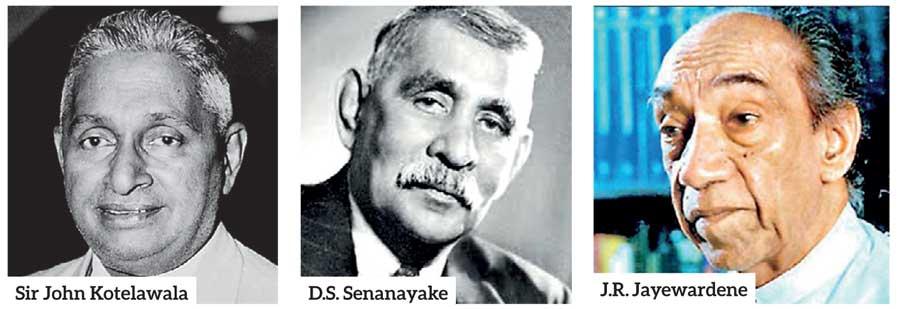Reply To:
Name - Reply Comment

The grand old party, like its off-shoot SLFP which has already disintegrated, is heading for an annihilation under ‘kick-off’ by its own ‘children’. It is timely that we trace the history and reflect upon the men who a century ago helped it pollinate, fertilise, germinate, and sprout, that over the years grew in to a huge tree.
Marriages of Kotalawale, Jayewardene and Senanayake to wealthy Attygalle girls of Madapatha eleven decades ago, instituted Uncle - Nephew Politics in Sri Lanka -1910/1980. DS Senanayake’s brother, Sir John Kotalawala’s father and JR Jayewardene’s uncle who married the three Attygalle off-spring, and got entangled in a family interweave of their fortunes, extended their relationship to politics. Mutual admiration and irritation, constant crave more conflict, by themselves or through their kinsfolk and children, they dominated politics of the country for seven decades.
Wickremesinghe Mudaliwas not a descendant of nobility resulting in power obtained from Kings, known as aristocrats. He belonged to low country Sinhalese who rose to some standing with accumulated wealth, and assumed a feudal lifestyle and established themselves as leading families in the low country, and were described, ‘Colonial Bourgeoisie’ by the emerging socialist groups of the times. The Mudali who hailed from Raigam Korale, after his shining military career he became the leading citizen of the village of Kotelawala, a village off Bandaragama, close to the ancient palace of Raigama. 
After one and a half centuries, the Kotelawalas shot back to the limelight with the appearance of Don Manuel Kotelawala [DM] Undugoda Arachchi, an inhabitant of Bandaragama. He had one son Don Andiris; he too was Arachchi who had two sons; Don Johannes Paulis Kotalawale, Head of Village Council and Don Jeramaih Aaron Kotalawale, Notary of Kalutara, who had ten sons and two daughters, the Police officer John being the eldest. He was the father of Sir John the third Prime Minister and Justin Kotalawala the Insurance tycoon and great-grandfather of business magnate Lalith Kotalawala and world-renowned Economist late Dr. Gamini Corea.
Another son of Kotalawala family was Muhandiram DC who hated the village life even as a teenager. He left the village to settle-down far away in Badulla in the Uva province. D C Kotalawala’s son, Sir Henry Kotelawala, represented Uva in the Legislative and State Councils in the 1920s and 1930s setting up a record as a member of the two Council for 26 consecutive years. JCT [Jack] Kotelawala, the popular Lanka Samasamaja Party Parliamentarian of the 1950s and 60s, the first Marxist in the Kotalawala dynasty was the son of Sir Henry.JCT and Sir John Kotalawala were second cousins who occupied seats across the well of the old parliament in Galle Face in the 1950/60s.
In the late 19th Century, precisely on April 1, 1886 when John Kotelawala from Madapatha in Piliyandala joined the Ceylon Constabulary [how the police were known then] as a Constable/Clerk, the OICs of the majority of Police stations were Sergeants. John was a smart police officer who rose to the rank of an inspector within a few years, a privileged position enjoyed mostly by the British. At that time in colonial Ceylon, most of the high ranking officers in all other institutions too were ‘Whites’. Before joining the Police as a young teenager in the village he was famous as a hellion or a roughneck. There were only a fewer number of Police stations 100 years ago. Most of the day to day law and order was handled by Village Headmen [civil matters] and by the Police Vidanes [minor issues of criminal nature]. The city of Colombo was different—there were several police stations that came under one single Inspector.
Naina was a notorious but powerful gangster who ran several gambling dens in the city, and no police officer, after they were either taught lessons by the criminal or being accommodated in his pay-list, dared disturb his activities. As reconstructed in the stage play ‘Nainage Sooduwa’,Kotelawala had gone to the infamous gambling hideout of Naina disguised as a gambler to apprehend the ‘big boss’ and became a hero after he successfully raided all his dens and put Naina in jail.
‘The Family of Attygalle is very ancient. The family traces its origin to a great degree from those who came to Ceylon during the King Rajasinghe era. The Attygalle name is derived from Atigale, a village near Hanwella.’ -20th C. Impressions-Arnold
Plumbago [graphite] miner-Arrack renter turned wealthy landowner from the same village was Colamunne Walawwa’s Mudaliyar Don Charles Gemoris Attygalle [1834-1901]. Known as the ‘graphite king’ as he was engaged in large scale mining of graphite. He was made Muhandiram in 1885 and propped up Mudaliyar in 1900 by the colonial government. Attygalle had four children, three daughters and the only son Francis Dixon.
Unlike Montagues and the Capulets of Verona, the Kotalawalas and Attygalles of Madapatha were not feuding families; in fact John’s mother Carolina was an Attygalle.
The tale that comes through grapevine for generations in the village of Colamunne, Madapatha relates how our young policeman John became a regular worshiper, at the village temple in his late 1920s. This temple was in close proximity to the Attygalle Walawwa which the Attygalle family frequented as well. The two young damsels, Alice 21, Leena 18 and little Ellen 9, and only brother Francis 12 were regularly seen at the temple along with their mother and a couple of maids, performing rituals on pinkama days.
A letter written by John was passed through a trusted village woman who frequented the Walawwa in performance of washing services, but received little or no response disappointing the young man. At the next pinkama held at the temple, he was somewhat successful in communicating his desires, which the lady responded with a non-verbal gesture… Since then John had been carrying on a covert love affair with the 21-year-old Alice Elizabeth Attygalle. John and Alice had little difficulty in exchanging communiqué and pleasantries helped by some young male and female attendants. However, a few months later, in the tale-end of 19th century, [1890s] Attygalles, the dominant family in the Salpiti-Korale gave the girl in marriage to her choice, with a dowry of an enormous wealth that included over 2,000 acres of plantations; one-fourth share of graphite mines, plus 200,000/- in cash.
The reason for the surprise change in the Attygalle elders’ stance is puzzling, though the village grapevine has many unauthenticated tales. How John comprehended the gambling den boss in the bazaar to an ignominious assault by methodically working out a strategy?
Alice’s younger sisters Leena and Ellen married JR’s uncle and DS’s brother in 1904 and 1910 respectively, paving the way for the birth of UNP in 1946 and establishment of Uncle Nephew Politics in Sri Lanka.
The author can be contacted at - [email protected]